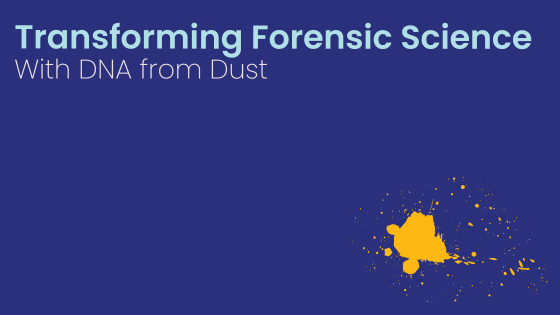Today’s guest blog is written by Anna Bennett, Promega. Reposted from Promega Connections with permission.
In the evolving field of forensic science, a study by Fantinato et al. has opened new avenues in using DNA extraction and analysis to recover important information from crime scenes. Their work, “The Invisible Witness: Air and Dust as DNA Evidence of Human Occupancy in Indoor Premises,” focuses on extracting DNA from air and dust. This novel approach could revolutionize how crime scenes are investigated, especially in scenarios where traditional evidence—like fingerprints or bodily fluids—is scarce, degraded or has been removed from surfaces.
Methodology of Sampling the Invisible
Humans naturally shed skin cells at a rate of about 1000 cells per cm² per hour, releasing billions of cells daily. These dead skin cells, known as corneocytes, are small enough to aerosolize through clothing and contain enough DNA to conduct STR analysis (Short Tandem Repeat analysis: commonly used in forensic science to compare DNA profiles between samples). Additionally, other microscopic carriers of DNA like dandruff and saliva are detectable in aerosols and dust within an environment.
In short, humans leave DNA behind in the air and dust of spaces they occupy. But the question remains: can DNA be recovered, isolated and then matched back to the individual who left it behind? This is of particular importance in complex criminal investigations where DNA from fingerprints or bodily fluids are often difficult to recover.
Fantinato et al. sought to test this exact question: Is it possible to extract DNA from the air or dust found inside buildings, and then use this DNA to identify people who have occupied those areas? To test this question, they collected 40 air samples and 144 dust samples from various indoor locations within their institute, including offices, meeting rooms and laboratories. Then, they isolated DNA from samples using the PowerQuant® System (Promega) on the 7500 RealTime PCR System (Applied Biosystems) and amplified DNA using the PowerPlex® Fusion 6C kit (Promega). Finally, they created a database containing DNA of consenting employees (n=55) to determine if the DNA they recovered from samples could be matched with DNA in the database.
The Complexity of DNA in Communal Spaces
In this work, Fantinato et al. found that dust samples were particularly rich in DNA. Dust samples served as a reservoir of genetic material from both current and historical occupants of a location. These dust DNA samples often contain complex mixtures of DNA, reflecting an accumulation of genetic material in communal, high-traffic spaces over time. In contrast, they found air samples typically represent more recent occupants, as DNA in the air tends to have a shorter preservation time compared to dust. In short—the DNA in dust is typically older than DNA in the air. Regardless of sample source, they found that environmental factors like light, heat, moisture and cleaning habits significantly influence the longevity and integrity of DNA in the sample.
They also found that offices, due to prolonged and consistent occupancy, tend to have higher DNA transfer rates. Using this information, they found offices have higher likelihood ratios (LR) for DNA profile matches (forensic science researchers often use a likelihood ratio to evaluate the strength of the match between a DNA profile obtained from an evidence sample and a DNA profile from a known individual, or reference sample). In contrast, they found laboratories had lower LR ratios than offices. This difference could be because of strict cleaning protocols and controlled access points in laboratories, reducing DNA accumulation. Lastly, they found that that DNA recovery is influenced by factors like air exchange rates and room usage patterns, which ultimately affected the quality and quantity of DNA.
When the Dust Settles
In conclusion, these results support their initial hypothesis: human DNA can be isolated from both air and dust samples. However, success in matching the dust DNA profile back to an individual is highly dependent on external factors such as location of the sample, longevity of the individual in the space and environmental factors like temperature, cleanliness and air flow rates in the isolation location.
In the larger, forensic science picture: it is possible to recover DNA evidence from dust left behind at a crime scene. But matching DNA back to a perpetrator could be difficult if the area was vigorously cleaned prior to investigation or if the area is a public space with high foot traffic.
Overall, the study marks a significant advancement in forensic science, showcasing the potential of DNA in dust for solving crimes. These findings lay the groundwork for new methods for identifying DNA in a criminal investigation without having to rely on fingerprints or bodily fluids alone. This approach, however, requires careful consideration of the entire suite of evidence, potential for contamination and emphasizes the need for ongoing research and development in this field.
Read the full article here: The invisible witness: air and dust as DNA evidence of human occupancy in indoor premises | Scientific Reports (nature.com)
WOULD YOU LIKE TO SEE MORE ARTICLES LIKE THIS? SUBSCRIBE TO THE ISHI BLOG BELOW!
SUBSCRIBE NOW!


